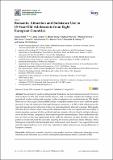| dc.contributor.author | Költő, András | |
| dc.contributor.author | Cosma, Alina | |
| dc.contributor.author | Young, Honor | |
| dc.contributor.author | Moreau, Nathalie | |
| dc.contributor.author | Pavlova, Daryna | |
| dc.contributor.author | Tesler, Riki | |
| dc.contributor.author | Thorsteinsson, Einar B. | |
| dc.contributor.author | Vieno, Alessio | |
| dc.contributor.author | Saewyc, Elizabeth M. | |
| dc.contributor.author | Nic Gabhainn, Saoirse | |
| dc.date.accessioned | 2020-07-15T07:43:49Z | |
| dc.date.available | 2020-07-15T07:43:49Z | |
| dc.date.issued | 2019-08-23 | |
| dc.identifier.citation | Költő, András, Cosma, Alina, Young, Honor, Moreau, Nathalie, Pavlova, Daryna, Tesler, Riki, Thorsteinsson, Einar B. Vieno, Alessio, Saewyc, Elizabeth M., Nic Gabhainn, Saoirse. (2019). Romantic Attraction and Substance Use in 15-Year-Old Adolescents from Eight European Countries. International Journal of Environmental Research and Public Health, 16(17), 3063, doi:10.3390/ijerph16173063 | en_IE |
| dc.identifier.issn | 1660-4601 | |
| dc.identifier.uri | http://hdl.handle.net/10379/16076 | |
| dc.description.abstract | Sexual minority youth are at higher risk of substance use than heterosexual youth. However, most evidence in this area is from North America, and it is unclear whether the findings can be generalized to other cultures and countries. In this investigation, we used data from the 2014 Health Behaviour in School-aged Children (HBSC) study to compare substance use in same- and both-gender attracted 15-year-old adolescents from eight European countries (n = 14,545) to that of their peers who reported opposite-gender attraction or have not been romantically attracted to anyone. Both-gender attracted, and to a lesser extent, same-gender attracted adolescents were significantly more likely to smoke cigarettes, consume alcohol, get drunk and use cannabis, or be involved in multiple substance use in the last 30 days compared to their opposite-gender attracted peers. Those adolescents who have not been in love had significantly lower odds for substance use than all other youth. The pattern of results remained the same after adjusting for country, gender and family affluence. These findings are compatible with the minority stress and romantic stress theories. They suggest that sexual minority stigma (and love on its own) may contribute to higher substance use among adolescents in European countries. | en_IE |
| dc.description.sponsorship | HBSC Belgium (FWB) is funded by the Wallonia-Brussels Federation (FWB), the Office of Birth
and Childhood (ONE), the Walloon Region and the Brussels-Capital Region. HBSC Bulgaria is funded by
UNICEF-Bulgaria. HBSC England is funded by the Department of Health and Social Care. HBSC France is funded
by Santé Publique France and OFDT (French Monitoring Centre for Drug Use and Addiction). HBSC Hungary
is funded by ELTE Eötvös Loránd University. HBSC Iceland is funded by grants from the Icelandic Directorate
of Health, KEA and the University of Akureyri. North Macedonia is funded by the United Nations Population
Fund/United Nations Development Programme. HBSC Switzerland is funded by the Swiss Federal Office of
Public Health and most of the Swiss cantons. The study was funded in part by grant #FDN 154335 from the
Canadian Institutes of Health Research (Saewyc, PI). | en_IE |
| dc.format | application/pdf | en_IE |
| dc.language.iso | en | en_IE |
| dc.publisher | MDPI | en_IE |
| dc.relation.ispartof | International Journal Of Environmental Research And Public Health | en |
| dc.rights | Attribution-NonCommercial-NoDerivs 3.0 Ireland | |
| dc.rights.uri | https://creativecommons.org/licenses/by-nc-nd/3.0/ie/ | |
| dc.subject | adolescents | en_IE |
| dc.subject | romantic attraction | en_IE |
| dc.subject | same-gender attraction | en_IE |
| dc.subject | both-gender attraction | en_IE |
| dc.subject | sexual minority youth | en_IE |
| dc.subject | substance use | en_IE |
| dc.subject | alcohol consumption | en_IE |
| dc.subject | drunkenness | en_IE |
| dc.subject | tobacco | en_IE |
| dc.subject | cannabis | en_IE |
| dc.subject | HBSC | en_IE |
| dc.title | Romantic attraction and substance use in 15-year-old adolescents from eight European countries | en_IE |
| dc.type | Article | en_IE |
| dc.date.updated | 2020-05-28T07:39:10Z | |
| dc.identifier.doi | 10.3390/ijerph16173063 | |
| dc.local.publishedsource | https://doi.org/10.3390/ijerph16173063 | en_IE |
| dc.description.peer-reviewed | peer-reviewed | |
| dc.internal.rssid | 19557471 | |
| dc.local.contact | Saoirse Nic Gabhainn, Dept. Of Health Promotion, Aras Moyola, Nui Galway. 3093 Email: saoirse.nicgabhainn@nuigalway.ie | |
| dc.local.copyrightchecked | Yes | |
| dc.local.version | PUBLISHED | |
| nui.item.downloads | 150 | |


